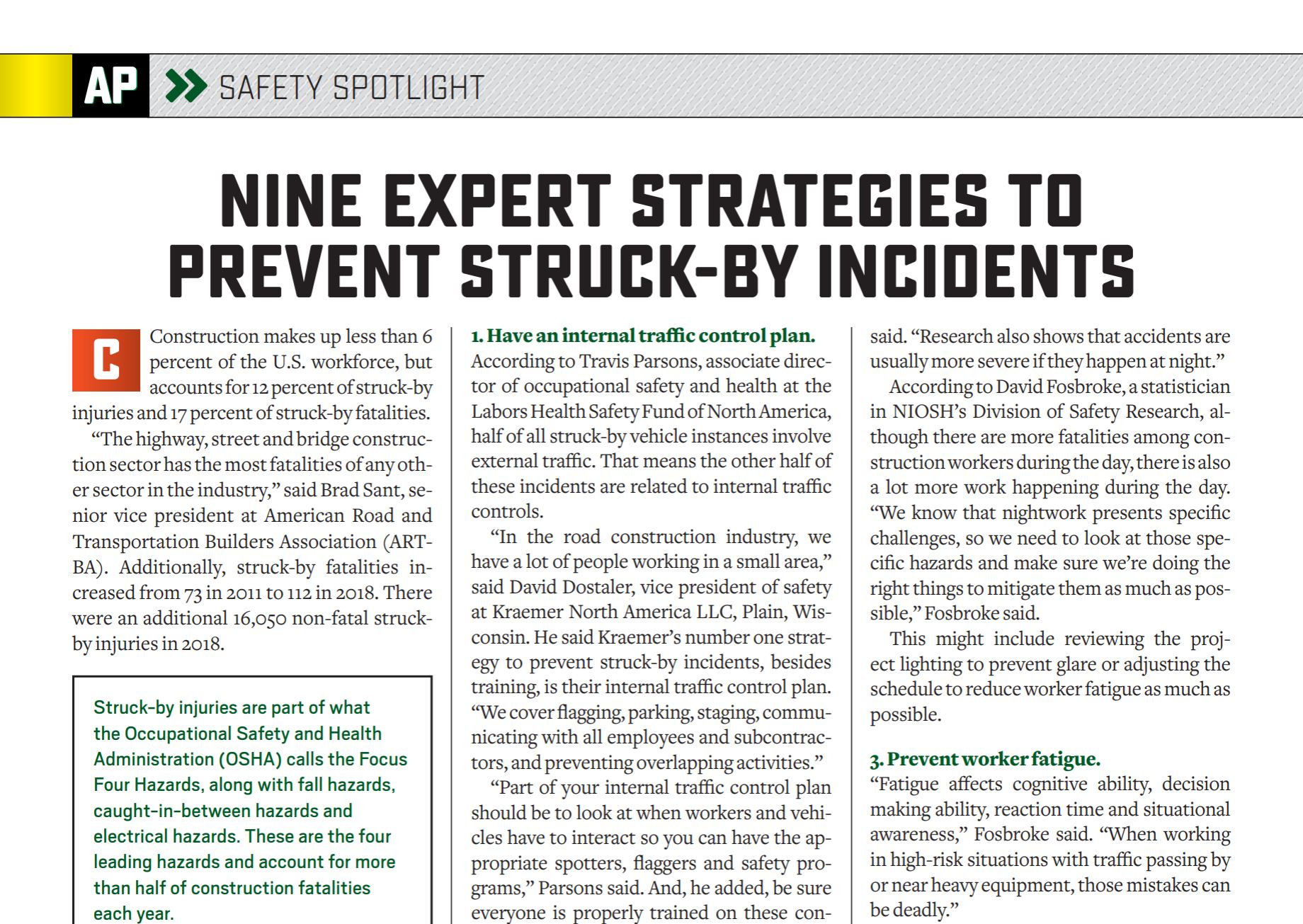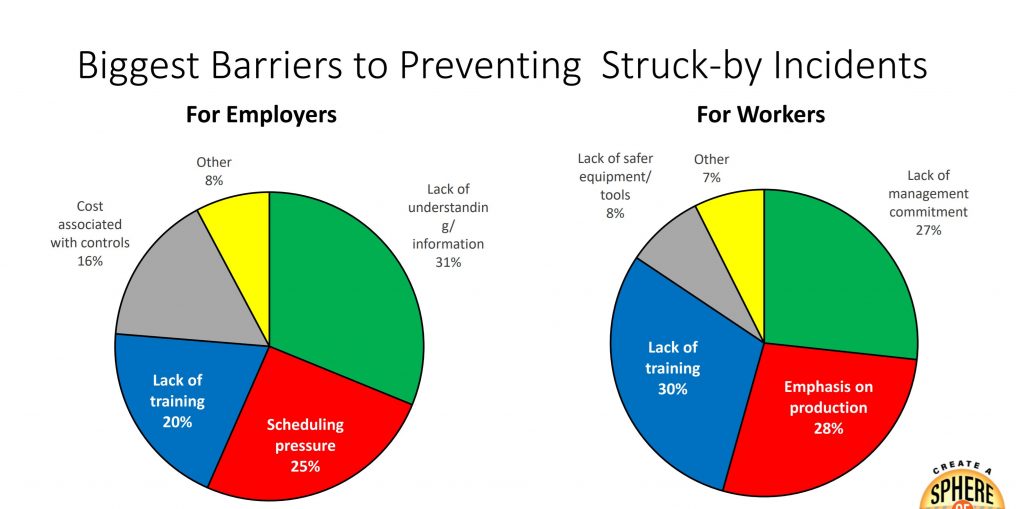9 Expert Strategies to Prevent Struck-By Incidents
BY AsphaltPro Staff

Construction makes up less than 6 percent of the U.S. workforce, but accounts for 12 percent of struck-by injuries and 17 percent of struck-by fatalities.
“The highway, street and bridge construction sector has the most fatalities of any other sector in the industry,” said Brad Sant, senior vice president at American Road and Transportation Builders Association (ARTBA). Additionally, struck-by fatalities increased from 73 in 2011 to 112 in 2018. There were an additional 16,050 non-fatal struck-by injuries in 2018.
Struck-by injuries are part of what the Occupational Safety and Health Administration (OSHA) calls the Focus Four Hazards, along with fall hazards, caught-in-between hazards and electrical hazards. These are the four leading hazards and account for more than half of construction fatalities each year.
According to a recent National Institute for Occupational Safety and Health (NIOSH) survey, respondents said the biggest barriers employers face to prevent struck-bys include a lack of understanding/information (31 percent), scheduling pressure (25 percent), lack of training (20 percent), cost associated with controls (16 percent), and other (8 percent). Workers reported that the biggest barriers they experience include lack of training (30 percent), emphasis on production (28 percent), lack of management commitment (27 percent), lack of safer equipment/tools (8 percent), and other (7 percent).
The first National Safety Stand-Down to Prevent Struck-By Incidents was held earlier this year, coinciding with National Work Zone Awareness Week. During the Stand-Down, the Center for Construction Research and Training (CPWR) held a webinar of experts who shared a number of tips to prevent struck-by incidents in work zones. Here, we share some of their insights.
1. Have an internal traffic control plan.
According to Travis Parsons, associate director of occupational safety and health at the Labors Health Safety Fund of North America, half of all struck-by vehicle instances involve external traffic. That means half of these incidents are related to internal traffic controls.
“In the road construction industry, we have a lot of people working in a small area,” said David Dostaler, vice president of safety at Kraemer North America LLC, Plain, Wisconsin. He said Kraemer’s number one strategy to prevent struck-bys, besides training, is their internal traffic control plan.“We cover flagging, parking, staging, communicating with all employees and subcontractors, and preventing overlapping activities.”

Graphic courtesy of CPWR
“Part of your internal traffic control plan should be to look at when workers and vehicles have to interact so you can have the appropriate spotters, flaggers and safety programs,” Parsons said. And, he added, be sure everyone is properly trained on these controls and the processes from the beginning of the job to the end.
Jerral Wyer, who had been the director of occupational safety and health at the Texas Department of Transportation until his retirement in 2018, reiterated the importance of teaching workers how to set up and maintain safety devices.
Parsons also suggested separating workers from vehicles and heavy equipment whenever possible. He recognized that space may be limited on some projects, but “it’s best practice to do it whenever possible.” Establish a worker-free zone, especially in times when equipment or vehicles will be backing up more often than is typical. Better yet, he said, eliminate backing up as much as possible. This can be achieved by setting up the work zone smartly.
2. Be particularly cautious on night jobs.
“Working at night is inherently more dangerous for several reasons,” Parsons said. The traveling public seems to drive faster at night and there are more big trucks on the road, he said. “Research also shows that accidents are usually more severe if they happen at night.”
According to David Fosbroke, a statistician in NIOSH’s Division of Safety Research, although there are more fatalities among construction workers during the day, there is also a lot more work happening during the day. “We know that nightwork presents specific challenges, so we need to look at those specific hazards and make sure we’re doing the right things to mitigate them as much as possible,” Fosbroke said.
This might include reviewing the project lighting to prevent glare or adjusting the schedule to reduce worker fatigue as much as possible.
3. Prevent worker fatigue.
“Fatigue affects cognitive ability, decision making ability, reaction time and situational awareness,” Fosbroke said. “When working in high-risk situations with traffic passing by or near heavy equipment, those mistakes can be deadly.”
He suggests implementing a fatigue management program to review scheduling and ensure workers understand the contributing factors, signs and risks of fatigue, as well as how to manage fatigue on the job. For more information about establishing a fatigue management program, Fosbroke suggested reading the Transportation Research Board’s Guide to Identifying and Reducing Workforce Fatigue in Rapid Renewal Projects.
Acting Director of NIOSH’s Office of Construction Safety and Health Scott Earnest continued, “Fatigue is not only important for workers themselves, but also drivers going through work zones.”
4. Use positive protection when possible.
“When it comes to third-party motorists, we don’t have control over them,” Wyer said. “That’s where external traffic control is so essential to ensure we’re meeting or exceeding standards.”
Fosbroke said positive protection is “the way to go” on long-term projects. The Federal Highway Administration defines positive protection devices as those “that contain and redirect vehicles, reducing vehicle intrusion into the workspace.” This includes various types of barriers, crash attenuator vehicles or vehicle arresting systems.
“Jobs that appropriately use positive protection make it clear for motorists where they are supposed to be and reduce the urge to cut in between barrels,” Fosbroke said. However, he added, positive protection may not be reasonable for every project, due to timelines or cost.
5. Find funds for optimal protection measures.
“The federal highway system is based on a low bid,” Parsons said. “Unfortunately, shortcuts can be taken and some of the protection measures aren’t deployed because of cost.” He recommended seeking funding from other sources, for example from the Highway Safety Improvement Program.
Wyer suggested also looking to state funding solutions. “In Texas, we set aside a dollar figure to be used as an investment fund to help improve safety on our construction projects,” he said. Wyer also suggested state DOTs specify more protection measures up front, “so everyone can bid on an even playing field and no bidder needs to be short on safety.”
6. Utilize law enforcement–but safely.
For short duration projects where it’s difficult to put up positive barriers, Dostaler suggested hiring law enforcement to help slow down traffic. “We’ve had very good luck with that,” he said, adding that it encourages people to “do what they should be doing anyway.” In many cases, he added, the client has been willing to help with the cost of hiring law enforcement.
However, Fosbroke warned, do so safely. “It’s easy to place law enforcement in the buffer space as traffic enters the work zone,” he said. “That makes sense for visibility, but we need to keep in mind that the buffer space’s intention is for motorists who don’t get over in time to have the space needed to come to a complete stop before hitting anything–including a police cruiser.”
There have been numerous cases where law enforcement officers have been killed trying to slow down traffic at work zones. “They are also part of that internal traffic control plan, and that requires good coordination between law enforcement, the contractor, and the state.”
7. Consider new technologies to improve safety.
Kraemer did some research in its work zones and discovered that a combination of video cameras with proximity detection has been useful, Dostaler said. There’s also some promise with RFID technology, GPS and radar systems in different applications.
Some promising research on the subject includes:
- Improving Work Zone Safety Utilizing a New Mobile Proximity Sensing Technology, from Georgia Institute of Technology
- Embedded Safety Communication System for Robust Hazard Perception of Individuals in Work Zones, from University of Las Vegas
- Reducing Highway Construction Fatalities Through Improved Adoption of Safety Technologies, from Oregon State University
AsphaltPro has also covered a number of innovative safety solutions, such as Oldcastle Materials’ AWARE alarm system. Learn more on our website at theasphaltpro.com.
Dostaler added, “We’re making progress each year. In the meantime, we have to lean heavily on best practices, such as internal traffic control plans and proper training for spotters and operators.”
Parsons gave a brief explanation of which standards contractors must follow. “OSHA is the law,” he said. “That’s the minimum requirement when it comes to worker safety.” Then, there’s the Manual on Uniform Traffic Control Devices, or MUTCD, the 2009 version of which is referenced in the OSHA standards. There’s also the American National Standards Institute’s Work Zone Safety Standard, which Parsons said is an “industry standard of recognized best practices.”
8. Keep up (or kick start) proven safety practices.
More than three fourths of all participants in the recent NIOSH survey ranked toolbox talks as the most effective way to raise awareness and change practices.
“Toolbox talks are one of the most significant things we can do when it comes to training,” Parsons said. “Training should happen every shift.”
Also important, Parsons said, is ensuring supervisors have the necessary soft skills to make critical decisions on traffic control set up and to lead their team. He recommended ARTBA’s supervisor training.
Offering a variety of training topics custom-tailored to the crew is also important. Case studies can be useful toolbox tip inspiration, as well. Building Safer Highway Work Zones, a document from NIOSH, offers 30 different case studies of fatality investigations.
“There’s no silver bullet to safety,” Dostaler said. However, recognizing that workers have different learning styles is very important. That’s why Kraemer doesn’t stop safety training after new hire orientation is over. “We continue with formal and informal training sessions, in classrooms and in the field.”
One of the most memorable training opportunities he’s witnessed with their crews is having crewmembers hop into a piece of machinery they don’t normally operate to see the blind spots for themselves. “Down on the ground, they don’t have the same kind of appreciation for it,” he said. “Rather than always reading them some info, get folks out of their comfort zone and let them take a look at what the other folks see.”
9. Make it stick.
Of the 243 participants in the recent NIOSH survey, more than half had first-hand experience with struck-by incidents, and one third of participants had been a victim of a struck-by incident. “When we asked those who had witnessed or been involved in a struck-by incident if anything had changed as a result, 86 percent said yes,” Sant said. However, less than half said that the change was permanent.
“We need to understand we have a huge challenge here,” Wyer said. During his more than 25 years at TxDOT, the department worked hard to reduce injuries from 1,600 to 200 per year. “Organizations have to be willing to look in the mirror and make a change, and it starts with the knowledge that we have to change. If we don’t, these fatalities will continue.”
Resources from CPWR, NIOSH, ARTBA, the Laborers’ Health and Safety Fund of North America, OSHA, and more can be found at cpwr.com/research/work-zone-safety.
